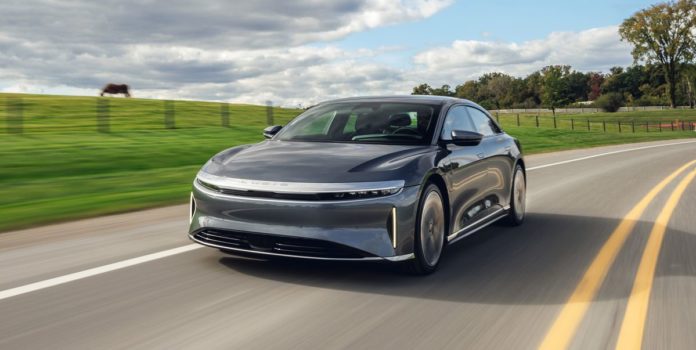From the December 2023 issue of Car and Driver.
Lucid has won plenty of praise from us for the range and performance of several Air sedan variants. The Air Grand Touring managed 410 miles on a charge in our 75-mph highway test, the best of any EV, and ripped to 60 mph in just 3.0 seconds. The new rear-wheel-drive Air Pure can’t match its grander siblings on those two metrics, but it adds a fresh virtue: value. At $78,900, the rear-wheel-drive Pure is $5000 less than the all-wheel-drive version and looks enticingly priced against rivals that include the Porsche Taycan and the Tesla Model S.
The entry-level Pure is the only rear-driver in the Air lineup and is not nearly as quick as its multi-motor counterparts. But it’s still plenty swift by mortal standards, zipping to 60 mph in 4.3 seconds and through the quarter-mile in 12.7 seconds at 113 mph (numbers nearly identical to the ones we extracted from the V-10-powered E60-generation BMW M5). Although there’s little drama from the rear tires during a hard launch, the traction-control system is working hard to get all 430 horsepower to the ground; for comparison, the 480-hp all-wheel-drive Pure managed a 3.5-second 60-mph run and an 11.7-second quarter-mile.
One reason for the rear-drive Pure’s lower price is its smaller 88.0-kWh battery pack. It doesn’t deliver the huge range claimed for the Air models fitted with the 112.0-kWh pack, but even so, this Pure boasts an EPA-estimated range of up to 419 miles on the standard 19-inch wheels. With the optional 20s, we went 300 miles in our 75-mph highway range test—still an impressive figure—during which the Air averaged a frugal 109 MPGe.
Beyond efficiency, rear-wheel drive brings dynamic benefits. On the road, this Pure feels more agile than the all-wheel-drive versions. One gets the sense of the rear end rotating under power, although stability control prevents significant oversteer. There’s also a useful weight reduction. At 4536 pounds, our test car was 415 pounds less portly than the all-wheel-drive Pure and 676 less than the Grand Touring. Steering feel is limited, but the rear-wheel-drive Pure responds keenly and grips impressively. Its 0.94 g of lateral acceleration on Michelin Pilot Sport EV rubber is 0.04 g better than its all-wheel-drive counterpart managed on the same tires. The 164-foot stop from 70 mph was four feet better too.
Braking, though, is not without issues. The Pure’s brake pedal has a dead spot at the top of its travel; it takes an uncomfortable amount of movement before the sense of slowing increases above that delivered by the always-present regenerative braking. There are only two regen settings, Standard and High, the latter serving as an aggressive one-pedal mode. We would appreciate a coast function.
Refinement is excellent, as the rear-wheel-drive Pure’s ride stays smooth over bumps and highway ridges despite our test car’s upsized wheels, and yet there’s little lean when cornering. At highway speeds, the most noticeable disturbance was the whisper of wind around the driver’s door mirror.
As before, the Air’s cabin is impressively spacious, especially in the back seat, where the smaller battery pack allows for a lower floor, enhancing rear legroom. But the rakish roofline makes getting in a squeeze, with taller occupants often bumping their heads.
The Pure lacks the more expensive variants’ standard glass roof, making the cabin seem darker but also less like an oven on sunny days. The materials feel plush, and the 34-inch curved display screen looks great. At the risk of sounding like Luddites, using a touch-sensitive panel to control the wipers and having to use the touchscreen to adjust mirrors and the steering wheel is deeply annoying.
The rear-drive Air Pure doesn’t flex with the EV overkill of its high-dollar siblings. But in its least expensive and basic form, the Air is a true luxury car and a value.
Specifications
Specifications
2024 Lucid Air Pure RWD
Vehicle Type: rear-motor, rear-wheel-drive, 5-passenger, 4-door sedan
PRICE
Base/As Tested: $78,900/$81,450
Options: 20-inch Aero Lite wheels, $1750; Fathom Blue Metallic paint, $800
POWERTRAIN
Motor: permanent-magnet synchronous AC, 430 hp, 406 lb-ft
Battery Pack: liquid-cooled lithium-ion, 88.0 kWh
Onboard Charger: 19.2 kW
Peak DC Fast-Charge Rate: 250 kW
Transmission: direct-drive
CHASSIS
Suspension, F/R: multilink/multilink
Brakes, F/R: 15.0-in vented disc/14.8-in vented disc
Tires: Michelin Pilot Sport EV
245/40ZR-20 99Y Extra Load LM1
DIMENSIONS
Wheelbase: 116.5 in
Length: 195.9 in
Width: 76.2 in
Height: 55.4 in
Passenger Volume: 101 ft3
Trunk Volume, F/R: 10/22 ft3
Curb Weight: 4536 lb
C/D TEST RESULTS
60 mph: 4.3 sec
100 mph: 9.8 sec
1/4-Mile: 12.7 sec @ 113 mph
Results above omit 1-ft rollout of 0.3 sec.
Rolling Start, 5–60 mph: 4.5 sec
Top Gear, 30–50 mph: 1.8 sec
Top Gear, 50–70 mph: 2.3 sec
Top Speed (gov ltd): 127 mph
Braking, 70–0 mph: 164 ft
Braking, 100–0 mph: 327 ft
Roadholding, 300-ft Skidpad: 0.94 g
C/D FUEL ECONOMY
Observed: 89 MPGe
75-mph Highway Driving: 109 MPGe
75-mph Highway Range: 300 mi
EPA FUEL ECONOMY
Combined/City/Highway: 130/134/126 mpg
Range: 394 mi
C/D TESTING EXPLAINED
Our man on the other side of the pond, Mike Duff lives in Britain but reports from across Europe, sometimes beyond. He has previously held staff roles on U.K. titles including CAR, Autocar, and evo, but his own automotive tastes tend toward the Germanic: he owns both a troublesome 987-generation Porsche Cayman S and a Mercedes 190E 2.5-16.

